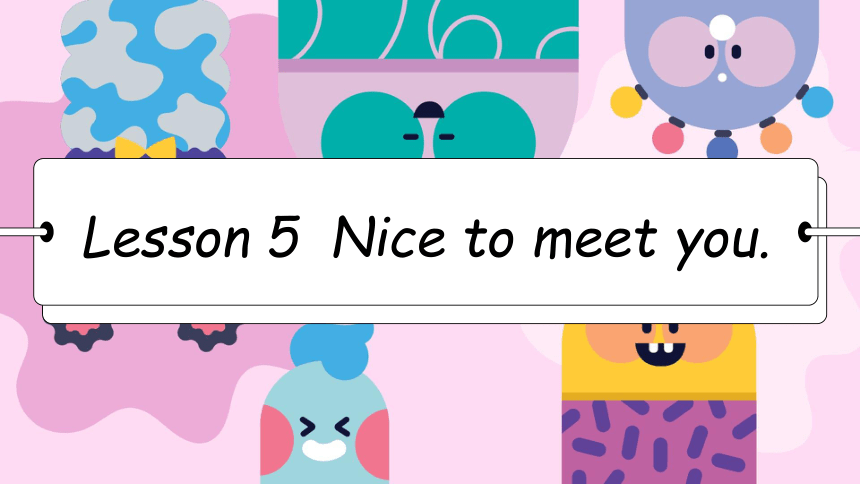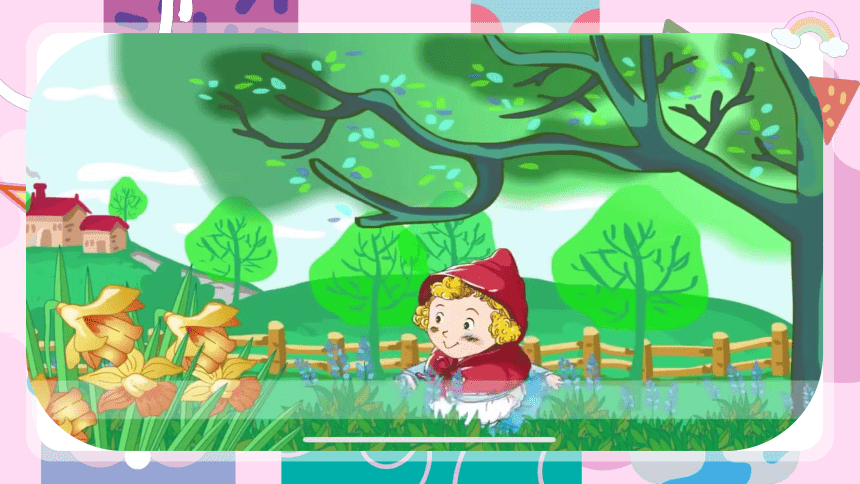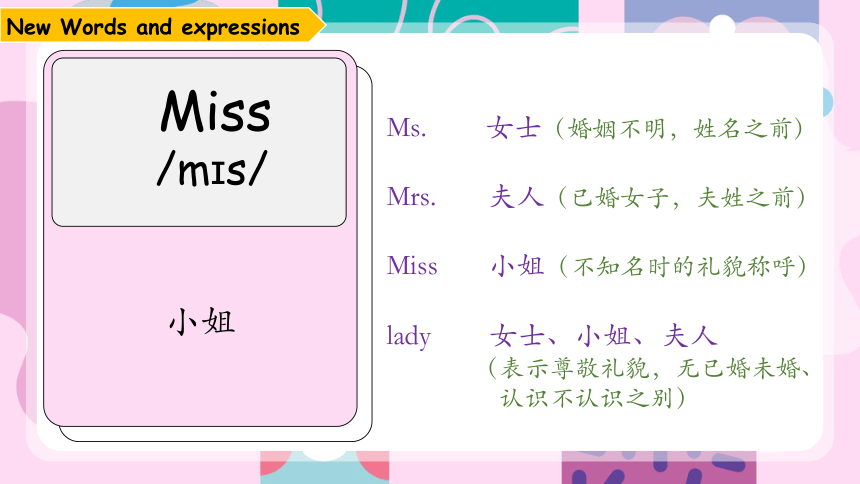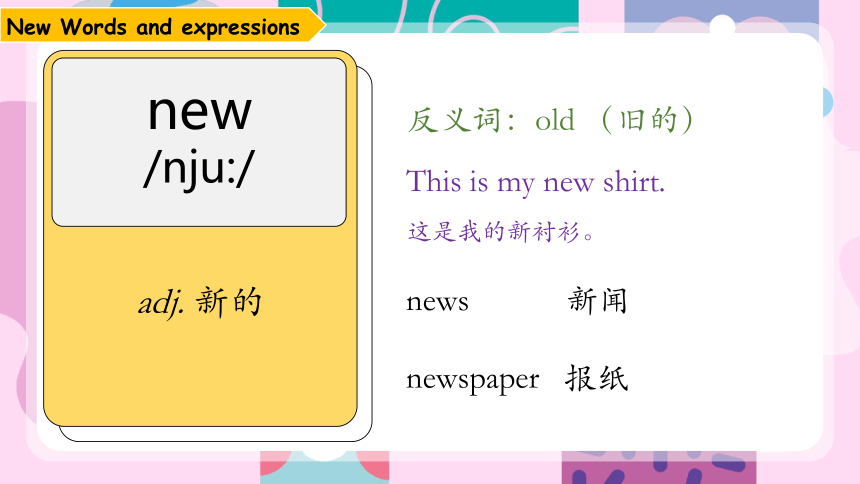新概念英语第一册 Lesson 05-06 Nice to meet you.课件(共30张PPT)
文档属性
| 名称 | 新概念英语第一册 Lesson 05-06 Nice to meet you.课件(共30张PPT) |  | |
| 格式 | pptx | ||
| 文件大小 | 90.2MB | ||
| 资源类型 | 试卷 | ||
| 版本资源 | 新概念英语 | ||
| 科目 | 英语 | ||
| 更新时间 | 2023-07-25 10:59:32 | ||
图片预览












文档简介
(共30张PPT)
Lesson 5 Nice to meet you.
number
先生
ticket
看谁最快读出?(+1)
看看谁丢了 ?(+1)
here
我的
daughter
Let’s review
学校
umbrella
suit
请
五
儿子
cloakroom
teacher
sorry
there
a number of
为...感到抱歉
...的数量
Warming up
n. 先生
Mr.
/’m st /
New Words and expressions
Mr. 先生
sir 先生
Ms. 女士
Mrs. 夫人
Miss 小姐
威猛先生
adj. 好
拓展词义:
n.优秀的
good
/g d/
反义词:bad
be good at 擅长做...
be good to 对...友好
bu good for 对...有好处
New Words and expressions
n. 早晨
morning
/’m :n /
New Words and expressions
afternoon 下午
noon 中午
evening 晚上
in the morning 在早上
小姐
Miss
/m s/
New Words and expressions
Ms. 女士(婚姻不明,姓名之前)
Mrs. 夫人(已婚女子,夫姓之前)
Miss 小姐(不知名时的礼貌称呼)
lady 女士、小姐、夫人
(表示尊敬礼貌,无已婚未婚、
认识不认识之别)
adj. 新的
new
/nju:/
New Words and expressions
反义词:old (旧的)
This is my new shirt.
这是我的新衬衫。
news 新闻
newspaper 报纸
n. 学生
student
/’stju:d nt/
New Words and expressions
pupil 小学生
learner 学者
scholar
top student 优等生;尖子生
adj. 美好的
拓展词义:
n.令人愉快的
nice
/na s/
New Words and expressions
very nice 很好,非常好
so nice 如此美好
be nice to sb. 对某人友好
have a nice time 玩得开心
v. 遇见
拓展词义:
n.见面;满足
meet
/mi:t/
Nice to meet you.
很高兴见到你。
New Words and expressions
too
/tu:/
adv. 也
Nice to meet you,too
我也很高兴见到你。
Nice to meet you,too.
adj & n.
法国的;法国人
French
/frent /
New Words and expressions
German /’d m n/
adj & n.
德国的;德国人
Japanese /d p’ni:z/
adj & n.
日本的;日本人
Korean /k ’r n/
adj & n.
韩国的;韩国人
Chinese /’t a ’ni:z/
adj & n.
中国的;中国人
Mr. /’m st / 先生
good /g d/ adj.好
morning /’m :n / adv.这里
Miss /m s/ 小姐
new /nju:/ adj.新的student /’stju:d nt/ n.学生
nice /na s/ adj.美好的
meet /mi:t/ v.遇见
too /tu:/ adv.也
French /frent / adj & n. 对不起的
German /’d m n/ adj & n. 先生
Japanese /d p’ni:z/ adj & n. 衣帽
Korean /k ’r n/ adj & n. 先生
Chinese /’t a ’ni:z/ adj & n. 先生
New Words and expressions
朗读并说出意思
morning
French
student
Japanese
new
German
Mr.
nice
good
Miss
Korean
Chinese
too
说出英文并拼出单词
德国的;德国人
先生
法国的;法国人
日本的;日本人
早晨
好
学生
小姐
新的
美好的
遇见
韩国的;韩国人
中国的;中国人
也
Watch the video then answer this question.
Is Chang-woo Chinese?
Analyze the passage
Good morning.
早上好。
Good morning.Mr.Blake.
早上好,布莱克先生。
下午好。
晚上好。
Good afternoon.
Good evening.
Analyze the passage
This is Miss Sophie Dupont.
Sophie is a new student.
She is French.
这位是索菲娅·杜邦小姐。
索菲娅是新来的学生。
她是法国人。
This is...
这是...,不仅可以用来表示事物,还可以用来介绍别人,
表示这是某某某。
eg:This is XXX.
Let’s have a try!
Analyze the passage
Sophie,this is Hans.
He is German.
—Nice to meet you.
And this is Naoko.
She’s Japanese.
—Nice to meet you.
And this is Chang-woo.
He’s Korean.
—Nice to meet you.
Analyze the passage
And this is Luming.
He’s Chinese.
—Nice to meet you.
And this is Xiaohui.
She’s Chainese,too.
—Nice to meet you.
Analyze the passage
初次见面时可以说Nice to meet you.
回答Nice to meet you,too.
初次见面时还可以说How do you do
回答 How do you do
在介绍自己是哪一个国家的人时,使用句型I’m+国家.
在介绍自己来自哪一个国家时,使用句型I‘m from+国家.
Let’s practise!
Lesson 6 What make is it
New Words and expressions
make /me k/
n. (产品的)牌号
Swedish /’swi:d /
adj. 瑞典的
Italian / ’t li n/
adj. 意大利的
American/ ’mer k n/
adj. 美国的
English /‘ ngl /
adj. 英国的
New Words and expressions
Peugeot /’p /
n. 标志
Fiat /’fi: t/
n. 菲亚特
Ford /f :d/
n. 福特
Mini /’m ni/
n. 迷你
Daewoo /’de wu:/
n. 大宇
Toyota /’t j t /
n. 丰田
Mercedes /m ‘se di:z/
n. 梅赛德斯
Volvo /’v lv /
n. 沃尔沃
It’s a Mini.(English)
It’s a Volvo.(Swedish)
It’s a Peugeot.(French)
It’s a Mercedes.(German)
It’s a Toyota.(Japanese)
It’s a Daewoo.(Korean)
What make is it 它是什么牌子的?
It’s a Ford.(American)
It’s a Fiat.(Italian)
疑问句分为一般疑问句和特殊疑问句。
首先,这是一个特殊疑问句。以特殊疑问词开头,对句中某一成分提问的句子,叫做特殊疑问句。回答特殊疑问句时,不能用“Yes”/“No”回答,问什么答什么。
特殊疑问词(“Wh-”&“H-”):
What(什么) Who(谁) Where(哪里) Why(为什么)
When(何时) Whose(谁的) Which(哪一个) Whom(Who的宾语)
How(怎么样,程度){How much(多少钱),How many(多少),
How long(多长),How far(多远)...
What make is it 它是什么牌子的?
What make is it
make作为名词,在句中作表语,有“品牌”的意思。
其中“it”作为代词,可用其他词替换,
eg:What make is this car?(这车是什么牌子的?)
What make is this pen?(这支钢笔是什么牌子的?)
要用“It’s...”来回答
What make is it 它是什么牌子的?
What make is it 它是什么牌子的?
模仿训练
What make is this car?
It’s a Volvo.
练习:
pen;pencil;bag;watch;telephone;computer...
Analyze the passage
一般疑问句:以be动词、助动词以及情态动词开头的疑问句,
“Yes”/“No”回答,用什么问 用什么答。
句型结构:be动词/助动词/情态动词+主语+其他?
eg:Are you tired ——Yes,I am.
Is this yours ——No,it isn’t.
Do you understand ——Yes,I do.
Let’s practise! P12 B
Homework
Lesson 5 Nice to meet you.
number
先生
ticket
看谁最快读出?(+1)
看看谁丢了 ?(+1)
here
我的
daughter
Let’s review
学校
umbrella
suit
请
五
儿子
cloakroom
teacher
sorry
there
a number of
为...感到抱歉
...的数量
Warming up
n. 先生
Mr.
/’m st /
New Words and expressions
Mr. 先生
sir 先生
Ms. 女士
Mrs. 夫人
Miss 小姐
威猛先生
adj. 好
拓展词义:
n.优秀的
good
/g d/
反义词:bad
be good at 擅长做...
be good to 对...友好
bu good for 对...有好处
New Words and expressions
n. 早晨
morning
/’m :n /
New Words and expressions
afternoon 下午
noon 中午
evening 晚上
in the morning 在早上
小姐
Miss
/m s/
New Words and expressions
Ms. 女士(婚姻不明,姓名之前)
Mrs. 夫人(已婚女子,夫姓之前)
Miss 小姐(不知名时的礼貌称呼)
lady 女士、小姐、夫人
(表示尊敬礼貌,无已婚未婚、
认识不认识之别)
adj. 新的
new
/nju:/
New Words and expressions
反义词:old (旧的)
This is my new shirt.
这是我的新衬衫。
news 新闻
newspaper 报纸
n. 学生
student
/’stju:d nt/
New Words and expressions
pupil 小学生
learner 学者
scholar
top student 优等生;尖子生
adj. 美好的
拓展词义:
n.令人愉快的
nice
/na s/
New Words and expressions
very nice 很好,非常好
so nice 如此美好
be nice to sb. 对某人友好
have a nice time 玩得开心
v. 遇见
拓展词义:
n.见面;满足
meet
/mi:t/
Nice to meet you.
很高兴见到你。
New Words and expressions
too
/tu:/
adv. 也
Nice to meet you,too
我也很高兴见到你。
Nice to meet you,too.
adj & n.
法国的;法国人
French
/frent /
New Words and expressions
German /’d m n/
adj & n.
德国的;德国人
Japanese /d p’ni:z/
adj & n.
日本的;日本人
Korean /k ’r n/
adj & n.
韩国的;韩国人
Chinese /’t a ’ni:z/
adj & n.
中国的;中国人
Mr. /’m st / 先生
good /g d/ adj.好
morning /’m :n / adv.这里
Miss /m s/ 小姐
new /nju:/ adj.新的student /’stju:d nt/ n.学生
nice /na s/ adj.美好的
meet /mi:t/ v.遇见
too /tu:/ adv.也
French /frent / adj & n. 对不起的
German /’d m n/ adj & n. 先生
Japanese /d p’ni:z/ adj & n. 衣帽
Korean /k ’r n/ adj & n. 先生
Chinese /’t a ’ni:z/ adj & n. 先生
New Words and expressions
朗读并说出意思
morning
French
student
Japanese
new
German
Mr.
nice
good
Miss
Korean
Chinese
too
说出英文并拼出单词
德国的;德国人
先生
法国的;法国人
日本的;日本人
早晨
好
学生
小姐
新的
美好的
遇见
韩国的;韩国人
中国的;中国人
也
Watch the video then answer this question.
Is Chang-woo Chinese?
Analyze the passage
Good morning.
早上好。
Good morning.Mr.Blake.
早上好,布莱克先生。
下午好。
晚上好。
Good afternoon.
Good evening.
Analyze the passage
This is Miss Sophie Dupont.
Sophie is a new student.
She is French.
这位是索菲娅·杜邦小姐。
索菲娅是新来的学生。
她是法国人。
This is...
这是...,不仅可以用来表示事物,还可以用来介绍别人,
表示这是某某某。
eg:This is XXX.
Let’s have a try!
Analyze the passage
Sophie,this is Hans.
He is German.
—Nice to meet you.
And this is Naoko.
She’s Japanese.
—Nice to meet you.
And this is Chang-woo.
He’s Korean.
—Nice to meet you.
Analyze the passage
And this is Luming.
He’s Chinese.
—Nice to meet you.
And this is Xiaohui.
She’s Chainese,too.
—Nice to meet you.
Analyze the passage
初次见面时可以说Nice to meet you.
回答Nice to meet you,too.
初次见面时还可以说How do you do
回答 How do you do
在介绍自己是哪一个国家的人时,使用句型I’m+国家.
在介绍自己来自哪一个国家时,使用句型I‘m from+国家.
Let’s practise!
Lesson 6 What make is it
New Words and expressions
make /me k/
n. (产品的)牌号
Swedish /’swi:d /
adj. 瑞典的
Italian / ’t li n/
adj. 意大利的
American/ ’mer k n/
adj. 美国的
English /‘ ngl /
adj. 英国的
New Words and expressions
Peugeot /’p /
n. 标志
Fiat /’fi: t/
n. 菲亚特
Ford /f :d/
n. 福特
Mini /’m ni/
n. 迷你
Daewoo /’de wu:/
n. 大宇
Toyota /’t j t /
n. 丰田
Mercedes /m ‘se di:z/
n. 梅赛德斯
Volvo /’v lv /
n. 沃尔沃
It’s a Mini.(English)
It’s a Volvo.(Swedish)
It’s a Peugeot.(French)
It’s a Mercedes.(German)
It’s a Toyota.(Japanese)
It’s a Daewoo.(Korean)
What make is it 它是什么牌子的?
It’s a Ford.(American)
It’s a Fiat.(Italian)
疑问句分为一般疑问句和特殊疑问句。
首先,这是一个特殊疑问句。以特殊疑问词开头,对句中某一成分提问的句子,叫做特殊疑问句。回答特殊疑问句时,不能用“Yes”/“No”回答,问什么答什么。
特殊疑问词(“Wh-”&“H-”):
What(什么) Who(谁) Where(哪里) Why(为什么)
When(何时) Whose(谁的) Which(哪一个) Whom(Who的宾语)
How(怎么样,程度){How much(多少钱),How many(多少),
How long(多长),How far(多远)...
What make is it 它是什么牌子的?
What make is it
make作为名词,在句中作表语,有“品牌”的意思。
其中“it”作为代词,可用其他词替换,
eg:What make is this car?(这车是什么牌子的?)
What make is this pen?(这支钢笔是什么牌子的?)
要用“It’s...”来回答
What make is it 它是什么牌子的?
What make is it 它是什么牌子的?
模仿训练
What make is this car?
It’s a Volvo.
练习:
pen;pencil;bag;watch;telephone;computer...
Analyze the passage
一般疑问句:以be动词、助动词以及情态动词开头的疑问句,
“Yes”/“No”回答,用什么问 用什么答。
句型结构:be动词/助动词/情态动词+主语+其他?
eg:Are you tired ——Yes,I am.
Is this yours ——No,it isn’t.
Do you understand ——Yes,I do.
Let’s practise! P12 B
Homework
同课章节目录
- Unit 16 On the London Eye
- Unit 17 Smile,please!
- Unit 18 Men can cook,too!
- Unit 19 You must eat!
- Unit 20 What a surprise!
- Unit 21 Breakfast blues
- Unit 22 Watching the neighbours
- Unit 23 An expensive camera
- Unit 24 A light dinne
- Unit 25 The weekend shopping
- Unit 26 A self-service restaurant
- Unit 27 Toothache
- Unit 28 Every day is different!
- Unit 29 Many happy returns of the day!
- Unit 30 An internation event
